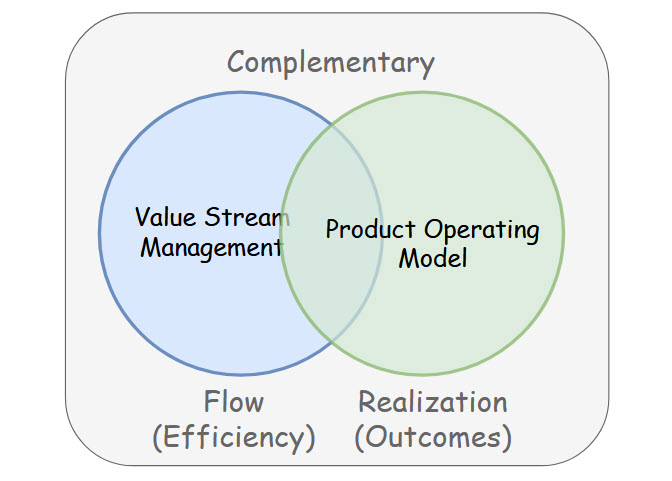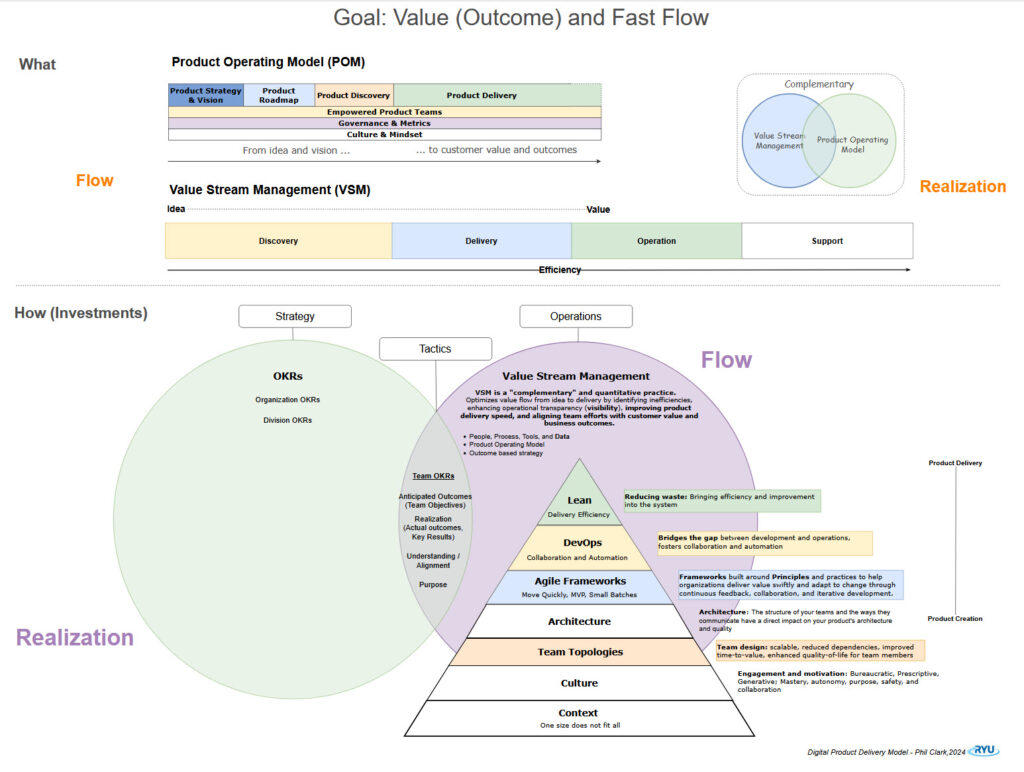7 min read

“The future of software delivery isn’t about process versus structure — it’s about harmonizing both to deliver better, faster, and smarter.”
Next month, I am invited to meet with a senior leader from a large organization, who is also a respected industry figure, to discuss their Product Operating Model. I initially saw it as a good opportunity to prepare and share insights. Instead, it sparked an important realization.
In late 2020, I introduced Value Stream Management (VSM) to our organization, initiating the integration process in 2021. At the time, this marked the beginning of my understanding of VSM and our first attempt to implement it. Since then, we’ve gained more profound insights and valuable lessons, allowing us to refine our approach.
Recently, when asked about Value Stream Management (VSM), I explained that it helps make our Agile, Lean, and DevOps investments visible.
Now, with our VSM 1.5 approach, I highlight that it also makes our investments in Agile, Lean, DevOps, OKRs, and Outcomes more transparent.

Today, we are evolving our Value Stream Management (VSM) practices into what we now call VSM 1.5 (assuming we started at 0.9 or 1.0).
We took a more logical approach to redefining our Value Streams and aligning teams. We’ve also improved how we focus on metrics and hold discussions while requiring the anticipated outcomes of each Initiative or Epic to be documented in Jira. I outlined a strategy for leveraging team-level OKRs to align with broader business outcomes. I’ve also briefly touched on this concept in a few other articles.
As I prepared for this upcoming meeting, I came to a surprising realization:
We weren’t just implementing Value Stream Management — we were organically integrating Product Operating Model (POM) principles alongside it.
It wasn’t planned at first, but it’s now clear we weren’t choosing between two models. We were combining them — and that combination became the foundation for our next level of operational maturity. This evolution reflects our commitment to continuously improving and aligning our methodologies to deliver greater customer and business impact.
Value Stream Management and the Product Operating Model
In software engineering, a value stream refers to the steps and activities involved in delivering a product or service to the customer. Value Stream Management (VSM) is the practice of optimizing this flow to improve speed, quality, and customer value.
A Product Operating Model (POM) serves as the blueprint for how a company designs, builds, and delivers software products. It ensures that teams, processes, and investments are aligned to maximize the customer’s value, driven by clear anticipated outcomes.
At first glance, Value Stream Management and the Product Operating Model are separate approaches, each with its terminology and focus. But when you look deeper, they share the same fundamental spirit: ensuring that our work creates meaningful value for customers and the business.
Despite this shared purpose, their emphasis differs slightly:
- VSM focuses primarily on optimizing the flow of work — identifying bottlenecks, improving efficiency, and making work visible from idea to customer impact.
- POM focuses on structuring teams and organizing ways of working — ensuring that ownership, funding, and decision-making are aligned to achieve clear, outcome-driven goals.
Together, they are not competing models but complementary disciplines: one sharpening how work flows, the other sharpening how teams are structured to deliver purposeful outcomes.
The key difference is where they start:
- VSM starts with flow efficiency and system visibility.
- POM starts with structure and ownership of the business outcome.
Why Combining POM and VSM Creates a Stronger Operating Model
Structure without optimized flow risks bureaucracy and stagnation.
Flow optimization without clear ownership and purpose risks fragmentation — and worse, the acceleration of delivering the wrong things faster.
Without aligning structure and flow to meaningful business and customer outcomes, organizations may become highly efficient at producing outputs that ultimately fail to drive real value.
Together, they provide what modern digital organizations need:
- Product Operating Model (POM): Clear ownership, accountability, and alignment to expected business and customer outcomes.
- Value Stream Management (VSM): Optimized, visible, and continuously improving flow of work across the organization.
- Both combined: A complete operating model that structures teams around value and ensures that value flows efficiently to the customer.
When combined, POM and VSM offer a holistic view — structuring teams with purpose and optimizing how that purpose is realized through efficient delivery.
Industry Research: Reinforcing the Shift Toward Outcomes
Recent research reinforces the importance of this convergence. Planview’s 2024 Project to Product State of the Industry Report 1 found that elite-performing organizations are three times more likely to use cascading OKRs and measure success through business outcomes rather than output metrics. They are also twice as likely to regularly review Flow Metrics, confirming that outcome-driven practices combined with flow efficiency are becoming the new standard for high-performing organizations.
“Structure gives us ownership. Flow gives us visibility. Outcomes give us purpose. The strongest organizations master all three.”
Our Journey: VSM 1.5 as a Harmonization of POM and VSM
As we’ve matured our approach, it’s become clear that many of the practices we are implementing through VSM 1.5 closely align with the core principles of the Product Operating Model:
- Clear Value Stream Identity:
Using Domain-Driven Design (DDD) to define real business domains mirrors POM’s emphasis on persistent product boundaries. - Outcome Ownership:
Mandating anticipated and actual outcomes aligns directly with POM’s shift from measuring outputs to business impacts. - Cross-functional Accountability:
Structuring teams around value streams — not just skills or departments — mirrors the cross-functional empowerment central to POM. - Flow Visibility and Metrics:
Monitoring flow efficiency, team health, and quality reflects VSM’s original intent and POM’s focus on systemic improvement. - Customer-Centric Thinking:
Closing the loop to validate outcomes ensures that teams remain connected to customer value, not just internal delivery milestones.
In short, without realizing it at first, VSM 1.5 evolved into a model that harmonizes the structural clarity of the Product Operating Model with the operational discipline of Value Stream Management.
Recognizing Our Current Gaps
While VSM 1.5 represents a significant step forward, it is not the final destination. There are important areas where we are still evolving:
- Mid-Level OKR Development: While we have mandated anticipated outcomes at the initiative level, consistently translating these into clear, mid-level OKRs — and connecting team efforts explicitly to business outcomes — remains a work in progress. Strengthening this bridge will be critical to our long-term success.
- Funding by Product/Value Stream: Today, our funding models still follow more traditional structures. Based on my experience across the industry, evolving to product-based funding will require a longer-term cultural shift. However, we are laying the necessary foundation by focusing on outcome-driven initiatives, clear value stream ownership, and understanding the investment value of teams.
These gaps are not signs of failure. They prove we are building the muscle memory needed to achieve lasting, meaningful change.
The Practical Benefits We Are Seeing and Expect to See
- Stronger alignment between Product, Architecture, and Delivery.
- Reduced cognitive load for teams working within clear domain boundaries.
- Clearer prioritization, alignment, and purpose based on customer and business value.
- A cultural shift toward accountability not just for delivery but for results.
- Faster, better-informed decisions from improved visibility and flow insights.
- Sustained operational efficiency improvements through retrospectives, insights, and continuous experimentation.
Something to Think About for Leaders
If you’re leading digital transformation, don’t limit yourself to choosing a Product Operating Model or Value Stream Management.
The real transformation happens when you intentionally combine both:
- Structure teams around customer and business value.
- Optimize how work flows through those teams.
- Hold teams accountable not just for delivery but for real, measurable outcomes.
- Continuously learn and improve by leveraging data insights and closing the feedback loop.
The future of software delivery isn’t about process versus structure. It’s about harmonizing both to deliver better, faster, and smarter.
What We’ve Been Building
Preparing for this meeting has helped crystallize what we’ve been building:
a modern operating model that combines ownership, flow, and outcomes — putting customer and business value at the center of everything we do.
While our journey continues — and some cultural shifts are still ahead —
we have built the foundation for a more outcome-driven, operationally efficient, and scalable future.
While there’s still work to be done and cultural changes ahead, we’ve laid the groundwork for a future that is more focused on outcomes, efficient in operations, and ability to scale.
I’m looking forward to the upcoming conversation — to walk through their Product Operating Model, learn from their approach, and explore how it aligns with, replaces, or complements our evolution with Value Stream Management. It’s a conversation not just about methods, but about how organizations are shifting from tracking outputs to delivering true business impact.
Let’s keep the conversation going:
How is your organization evolving its operating model to drive outcomes over outputs — combining structure, flow, and purpose to create real value?
Related Articles
- From Feature Factory to Purpose-Driven Development: Why Anticipated Outcomes Are Non-Negotiable, April 12, 2025. Phil Clark.
References
Poking Holes
I invite your perspective on my posts. What are your thoughts?.
Let’s talk: [email protected]
